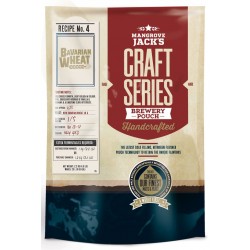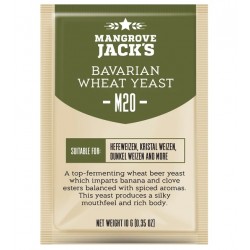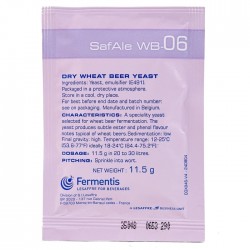
Although wheat beers are mainly associated with Germany, the origins of its history can be sought even in antiquity as the oldest Sumerian records found mention the use of spelt (i.e. one of the varieties of wheat) as early as 6000 BC. Wheat as one of the raw materials from which beer is made has always been popular. However, there were times when using it to brew the golden beverage was almost forbidden. Where? Well, in Bavaria which, rightly so, has been associated with wheat beers for hundreds of years.
A bit of history
Once of the first Weissbier decree was issued in Hamburg in 1410. It stated that white beer (as this is what the name Weissbier means) must have a strong malt accent, low bitterness and be yellow rather than red in color. 50 years later, it turned out that the recipe that was the "benchmark" had only 10% wheat in the hopping. Nevertheless, a chronicler well-known for the time, Dr. Henricus Knaustius, described the white beer from Hamburg as "the queen of all Weissbiers."
Wheat beers were therefore already produced in the Middle Ages. They were extremely popular in what is now Bavaria. However, a Europe plunged into wars, battled by crop failures and pestilence needed not so much beer as food, and more specifically bread. And the best raw material for its baking was, of course, wheat. This is why the city council of Munich banned the production of beer from wheat in 1447, which a few decades later, namely on April 23, 1516, was legally approved by Duke Wilhelm IV (pictured), regulating the production of beer, and more specifically its prices and the raw materials from which it could be made. It included water, barley and hops, excluding wheat. The law was called the Bavarian Purity Law, and in German it was called Reinheitsgebot. Similar regulations began to be introduced abroad as well.
In 1520, the same prince granted permission to brew this beer to the noble Degenberg family. He probably agreed to this solution because the production of wheat beer provided him with considerable income, and the product, due to the fact that it was forbidden in theory, had a very large margin, which meant that only wealthy citizens could afford to buy it.
In 1602, the last representative of the Degenberg family died, so Duke Maximilian Wittelsbach of Bavaria brought to Munich a long-time master of the brewing art, Siegmund Bettel. 3 years later, the first brewery to brew wheat beer was opened there. The production of this beer grew steadily, Weissbier gained in popularity and the budget revenues were enormous.
Over time, however, it began to lose its popularity in favor of barley beers, so in the late 19th century the Wittelsbach family allowed the nobility to make beers with wheat in them. By 1812, two breweries were already allowed to brew beers using wheat malt.
 As the popularity of Pilsner beers grew, the popularity of white beers declined. That is why in 1856 Georg Schneider was able to buy the right to brew wheat beers from the crown, although it was already an unpopular style at that time. Schneider (in the picture), however, believed that he would be able to restore the former fame of this beverage, so in 1872, together with his son, he bought the ducal brewery where he started brewing Weissbiery. The brewery founded almost 150 years ago is still in operation today.
As the popularity of Pilsner beers grew, the popularity of white beers declined. That is why in 1856 Georg Schneider was able to buy the right to brew wheat beers from the crown, although it was already an unpopular style at that time. Schneider (in the picture), however, believed that he would be able to restore the former fame of this beverage, so in 1872, together with his son, he bought the ducal brewery where he started brewing Weissbiery. The brewery founded almost 150 years ago is still in operation today.
However, it was not until the 1980s that it really came back into favor. The beer rather associated with the older German citizens began to be noticed by young people. The beverage quickly conquered the hearts of consumers all over the world, thanks to which it remains one of the most popular and recognisable styles in the world to this day.
Characteristics of the style
Wheat beer is a style of top fermentation. It is known that there is a great correlation between the temperature at which it ferments and the final taste, because Weissbier has a largely yeasty character and it is through their work that we should detect the aroma of ripe bananas and cloves in this beer. Isoamyl acetate and 4-vinegar-guaiacol are responsible for those. Additionally, it is characterized by high carbonation and rich, white, creamy head, which is the result of using wheat malts.
It can come in a cloudy version as "Hefe-Weizen", where hefe stands for yeast, and in a filtered version - kristalweizen.
According to German tradition, wheat malt should make up at least 50% of the total hopping.
 As for the aroma, it should have medium to high levels of phenols responsible for the clove aroma. The same goes for fruit esters - banana is a desirable aroma. Flavors of pear, peach, bubble gum and vanilla are also acceptable. The balance of these aromas can vary, but banana and cloves should be in the forefront.
As for the aroma, it should have medium to high levels of phenols responsible for the clove aroma. The same goes for fruit esters - banana is a desirable aroma. Flavors of pear, peach, bubble gum and vanilla are also acceptable. The balance of these aromas can vary, but banana and cloves should be in the forefront.
The hop aroma should be low, almost undetectable.
Additionally, a bread/beans aroma may be noticeable, this is also a result of using wheat malt.
As for the flavors, similar to the aroma, the banana and clove flavors should come through. Vanilla and bubble gum notes can also be perceptible, but none of them should dominate. A slight breadiness or wheat flavor is desirable. Low bitterness, almost undetectable. Slightly tart citrus notes can be detected as well. This is a result of yeast work and high carbonation. The finish is rather dry. The sweetness of the wheat beer is due to the lack of bitterness rather than deliberate mashing at higher temperatures.
The color should be in the pale straw to dark golden palette. Depending on whether it's filtered, it can be cloudy (due to the yeast thickening) - the hefe version, or clear, transparent - kristalweizen.
It is important to remember that this style should be refreshing - this means that the beer should not be heavy.
How to select yeast?
One of the most important elements when making wheat beer is yeast. At the moment, there are many types of yeast available on the market that meet the requirements for making this type of beer, namely high production of 4-vinylguaiacol (clove) and isoamyl acetate (banana), as well as low flocculation.
The most popular of these are:
The most popular of these are:
Fermentis WB-06 (dry),
Mangrove Jack's Bavarian Wheat M20 (dry),
Mauribrew Weiss y1433 (dry),
White Labs WLP300, WLP351, WLP380 (liquid),
Wyeast 3638, 3068 (liquid),
Omega OYL-021 (liquid),
Fermentum Mobile FM41 (liquid).
Wheat beer descendants
Wheat beer has seen many evolutions. Today it comes in American versions, Belgian versions, several German versions.
Today, the most popular styles that can be associated with German Weissen are:
- witbier (Belgium),
- belgian wit (Belgium)
- american wit (America)
- american wheat (America),
- american hefe (America),
- weizenbock (Germany),
- berliner weisse (Germany),
- dunkelweizen (Germany),
- gose (Germany)
These are just some of the varieties where wheat is one of the main components of the hopping. Each of them differs in taste, some have more noticeable bitterness and hop aromas, others less. Some are sour, some are sweet, and some, like gose, are slightly salty.

Wheat beer has had a rich and challenging history. Fortunately, the style still lives on today, allowing consumers around the world to enjoy its incredible flavor and even brew it without much trouble.
Bibliography:
1. Ray Daniels, Designing great beers,
2. https://www.bjcp.org/docs/2015_Guidelines_Beer.pdf
3. https://kompendiumpiwa.pl/weissbier/
4. https://schneider-weisse.de/en/node/16
Photos used:
1. photo by ELEVATE from Pexels
2. https://pl.wikipedia.org/wiki/Wilhelm_IV_z_Bawarii#/media/Plik:DH-Wilhelm_von_Bayern.jpg
3. https://schneider-weisse.de/en/node/16
4. photo by Alexand Podvalny from Pexels
5. https://pixabay.com/pl/photos/pszenica-ziarna-niwa-zbo%C5%BCa-sun-3506758/


























Dodaj komentarz
1 komentarze